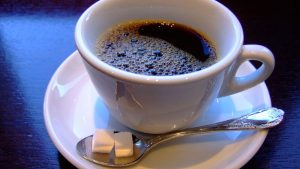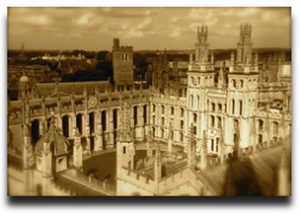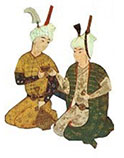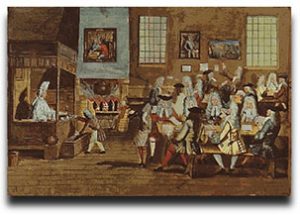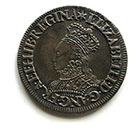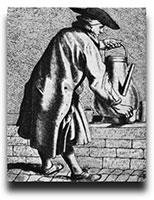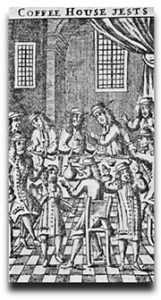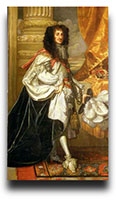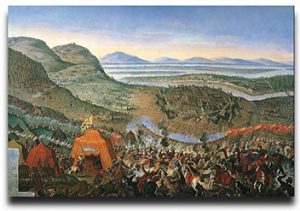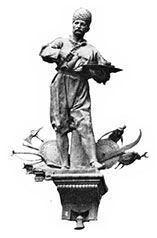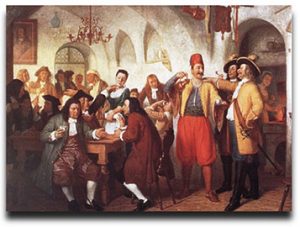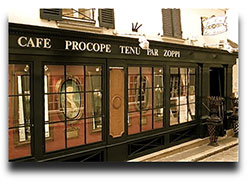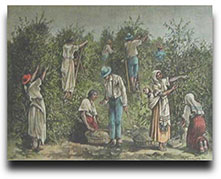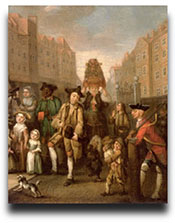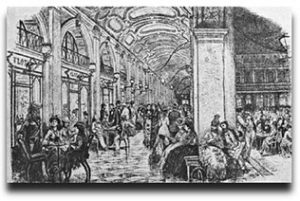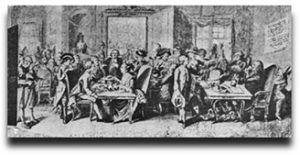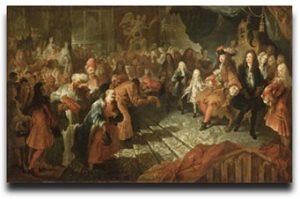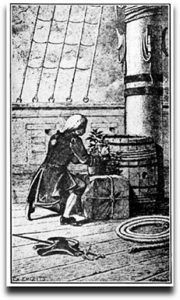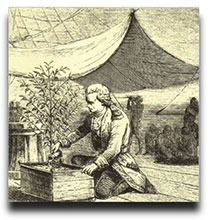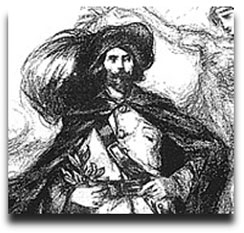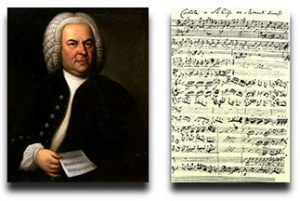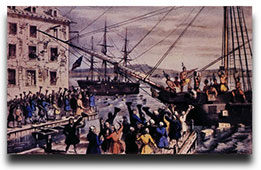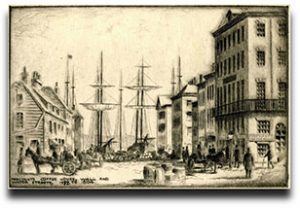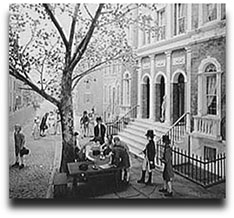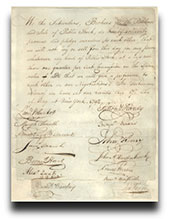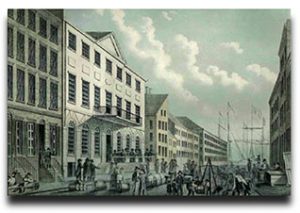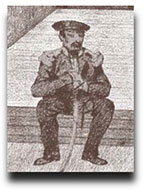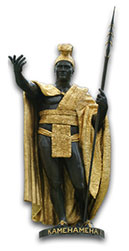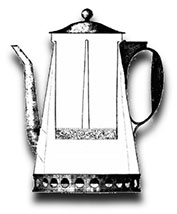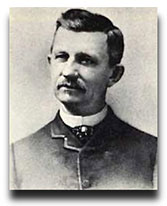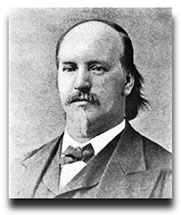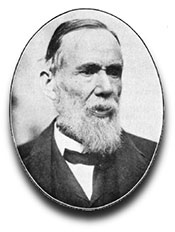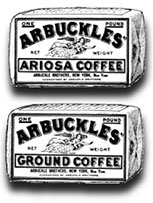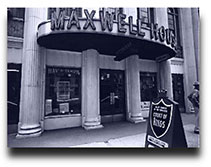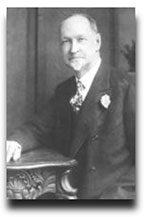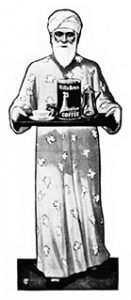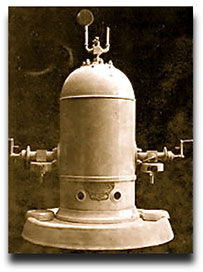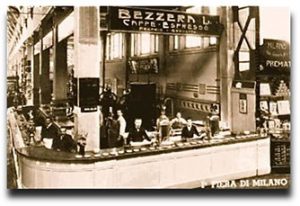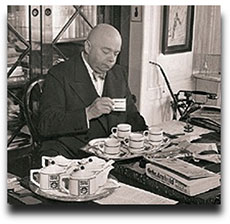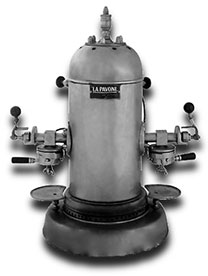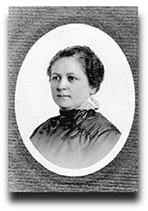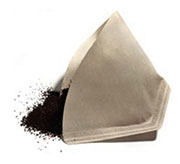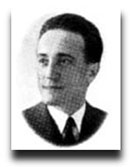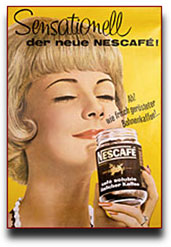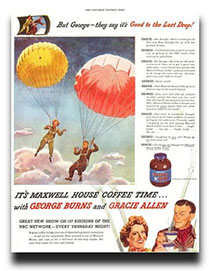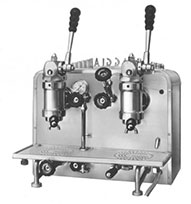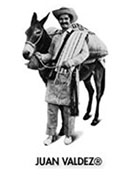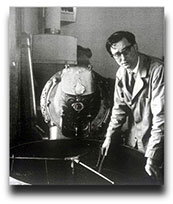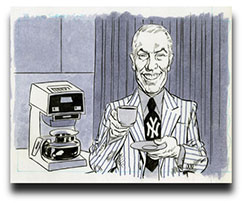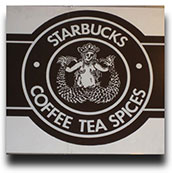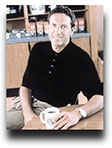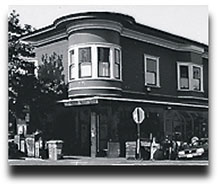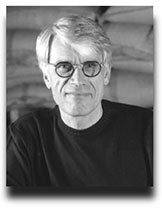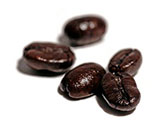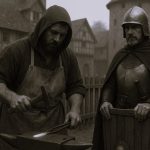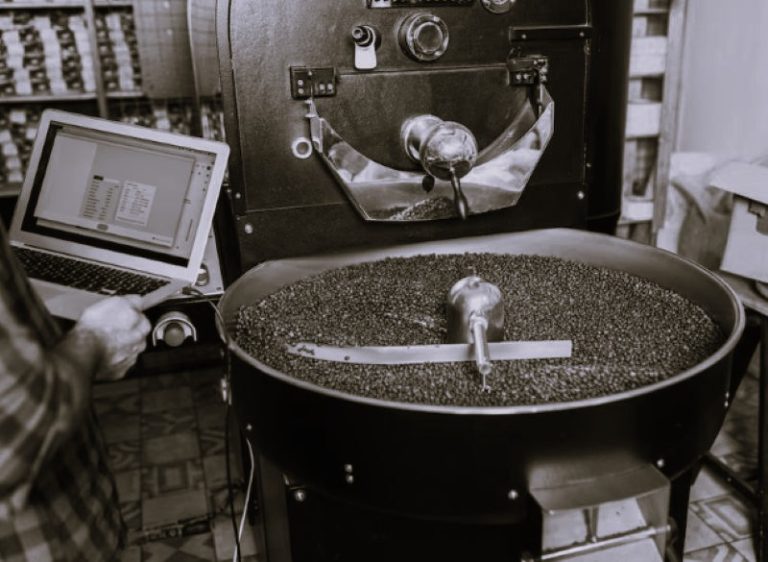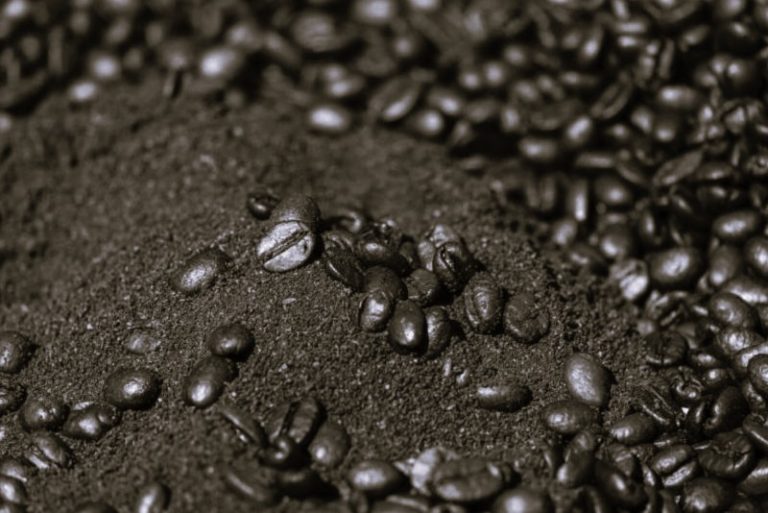The history of coffee… a simple timeline of events? I think not! No, the journey of coffee, my friends is so much more. It’s a swashbuckling adventure spanning a thousand years, filled with death-defying escapes, international intrigue and – oh yes! – torrid romance. From distant, tropical islands to the power centers of international trade, it has been banned, berated, hailed and championed, generating as much fear as enjoyment. This is not just a drink, this is magic, infusing itself into our psyche, stirring conflict and controversy. Read on, friends, and enjoy the bold, robust voyage that is coffee.
• 850
An Ethiopian herdsman named Kaldi observed his goat, frolicking in quite a chipper mood near a bush. Subsequently the goat chewed on the red berries and let out an exuberant “Baaaaaaahhh!” The coffee berry is discovered!

Kaldi sampled the berries himself. A feeling of elation consumed him. He declared to his goat, “These berries are heaven sent.” So excited, he and the goat ran to the nearest monastery, telling of their miraculous effect. “Baahhhhh!” “Baahhhhh!” The chief monk was not amused. “Are you possessed?” He condemned the berries as the Devil’s work and promptly threw them into the fire. “Evil!” But soon after, the smell of fresh roasted coffee filled the pious halls of the monastery, enticing the monks. After the chief monk dozed off, due to the lack of caffeine mind you, a young rebellious monk snatched the cooling beans from the fire pit. This innovator, the world’s first barista, mixed the beans with water and the resulting brew kept the monks up all night thanking their creator. “Hallelujah!” Quite a holy revelation, indeed!

Meanwhile, word of these fragrant, energizing berries traveled to another corner of Ethiopia and caught the imagination of the Galla tribe. The Galla mixed the berry with ghee, a clarified butter, and pressed the mixture into a scrumptious power bar. Their warriors marched into battle with their new, energizing snack and were invincible! In fact, similar bars are still eaten in Kaffa and Sidamo, Ethiopia to this day.
• 1000

Physician and philosopher Avicenna Bukhara writes the first known literature describing the medicinal properties of coffee. A true visionary!
• 1100

Enterprising Arab traders return to their homeland, now modern-day Yemen, with coffee from Ethiopia. They cultivate the plant for the first time on plantations and create a most satisfying, uplifting drink by boiling the beans in water. It is called “qahwa” or that which prevents sleep.
Incidentally qahwa, also written as “kahwah”, is one of many words Arabs used for wine. You see, in the process of stripping the coffee bean’s cherry-like husk, the pulp can be fermented to make a potent, alcoholic beverage with quite a kick in the palate! While the Koran forbids wine or other such intoxicants, Muslims enamored with coffee argue that the brew is actually a stimulant. Was it as good for you as it was for me?
• 1453

Ottoman Turks introduce coffee to the bustling power center of Constantinople. Those clever Turks add clove, cardamom, cinnamon and anise for a most spicy, energizing concoction. When in Istanbul, order this blast from the past that is still enjoyed to
this day.
• 1454
The Mufti of Aden visits the Ethiopian countryside and sees his own citizens drinking coffee. He must have a taste! The drink cures him of some unknown affliction and – voila! His approval helps spread coffee’s popularity all the way to Mecca. There, the first coffee houses are established, known as Kaveh Kanes, which are used for religious meetings. Gossip, singing and storytelling soon follow.
• 1475

Coffee shops open in Constantinople around this same time, which many claim are the first. They become hotspots for lively discussions and political debates.

In fact, coffee becomes so much a part of Turkish culture that they create a law that makes it legal for a woman to divorce her husband if he fails to provide her with her daily quota… of coffee that is. Coffee is widely held as an aphrodisiac. Hubba-hubba!
• 1511

The trouble begins! Just over 50 years after coffee houses gain popularity in Mecca, Governor Khayr Bey bans the drink, fearing its influence promoted energized discussions and debates
that could lead to opposition to his rule. He shuts down shops as far away as Constantinople. Riots break out, unrest spreads! And just when it appears a coffee revolution could erupt, the Sultan of Cairo intervenes. He sends word that coffee is sacred and has the Governor executed. Off with his head! The lesson here my fellow coffee lovers is, to always consult with your Superior first before making a rash decision and never, ever cut-off your bosses’ coffee supply.
To avoid execution, use Auto-Ship! Click here for details. Now back to history — Coffee’s place as a beloved beverage in the Muslim world is secured, but more importantly, its powerful influence is established. Rightly, so!
• 1570
Coffee arrives this year in Venice. This busy port city serviced the traders of the world where they exchanged their unique treasures. At first, this rare exotic find is made available only to the very wealthy, and was sometimes sold at premier lemonade stands for medicinal purposes.
• 1600

At this point, Arabia and Muslim Africa enjoyed a monopoly on coffee production; In order to keep it that way, their laws forbid the export of fertile beans. Fertile beans are those with the cherry still around the seed. Before they were exported, coffee beans were boiled to make them infertile by shedding the husk off to prevent clever smugglers from sneaking away with the precious goods. But nothing is fool-proof…

After his pilgrimage to Mecca, an Asian Indian named Baba Budan manages to leave the Muslim city with a few fertile coffee beans concealed against his stomach. After returning to India, he secretly cultivates the beans. The descendants of those well-traveled beans are still producing coffee to this day! In fact, “Old Chik”, as the original beans are known, account for approximately a third of the coffee India produces. No wonder Baba Budan was made a Saint and there’s a region of India named after him.

In Venice, the Church notices the increasing popularity of coffee. The local clergy believe it to be satanic, a product of Ottoman infidels. So Pope Clement VIII decides to inspect the dark beverage himself. The aroma was so pleasant and inviting, the Pope succumbs to temptation and tried the “devil’s concoction.” After tasting it, he proclaims, “Why, this Satan’s drink is so delicious that it would be a pity to let the Infidels have exclusive use of it. We shall fool Satan by baptizing it and making it a truly Christian beverage” and thank God he did! The wisdom of the Church triumphs again! Pass the donation plate; I’ll throw in a buck.
• 1607

Captain John Smith, a British world adventurer, who was one of the founders of the first English settlement Colony in Jamestown, Virginia, brings awareness of coffee to the newly discovered Americas. If fact, there’s mention of the Turkish drink known as coffa in his bestselling book of the day “Travels and Adventure.” Perhaps it is a good cup of coffee that drives him to such amazing discoveries, dangerous adventures and into trouble too. Not only was the rabble-rouser nearly executed just as he arrived in the New World by his fellow Englishmen, he got into a tussle with the Natives as well.

Legend has it, while up-river, searching for food; he crossed the line and was captured by the Powhatan Tribe. Just before his execution, the Chief’s beautiful 14 year-old daughter, Princess Pocahontas intervened. To spare him, she threw herself on top of the cocky Captain, willing to take a beating by clubs to protect him. The Chief relented to his daughter’s compassion and apparently her “school-girl” crush. Smith was freed. After the Captain had a “quickie” with Pocahontas — “a quickie cup of coffee that is,” the handsome Captain set-off. With a tip of his hat, a thank you and a wink, he left the blushing Princess Pocahontas behind. Rumor has it that these two had several rendezvous’ over the next several years. Although some say that she was in it for love, I think she was in it for the coffee.
• 1616
Successful cloth merchant and trader, Pieter Van Dan Broeck, was one of the first Dutchmen to taste coffee. Whilst in the service of the Dutch East India Company, he visited Mocha in
Yemen and drank “something hot and black.” Since it was illegal to take a precious coffee plant or its fertile seeds / beans out of the Arab lands, Pieter set out to smuggle one back to the Netherlands. Unfortunately for the Dutch, and fortunate for the Yemenis, the cultivation in Holland fails miserably. Thwarted in Antwerp by the fickle little plant, that preferred the warmer temperatures of the equatorial zones, the Dutch soon discovered they couldn’t grow this plant away from its origins as they had hoped. Not to be dissuaded, being the good businessmen they were, they set their sights on expanding from their near monopoly of the spice trade into coffee. They could see its potential and bided their time as they waited for the demand for coffee to take hold in Europe.
• 1637
A Greek student at Oxford University brews the very first cup of coffee in England. With his newfound get-up-and-go drink, Nathaniel Conopios could stay up all night throwing dishes and dancing, as well as cramming for those tricky tests, however Oxford’s porcelain was more precious to them, than he was. He was summarily expelled. Back to Greece for poor Nathaniel, yet coffee was here to stay. It played an on-going role at energized Oxford University. Scientific breakthroughs are soon to come.
• 1645
Seventy-five years after the beverage was first introduced in Venice, the first coffee house opens, catering to the travelers and trade between the Venetians and the Ottomans.
• 1650
Back to Oxford. The first coffee house in all of England opens near the University where eager students drive the drink’s popularity. A few years later, those caffeinated young men establish the Oxford Coffee Club. None of these brainiacs were summarily expelled; instead the college all- nighter was born! — And with it the creation of innovative theories and ideas shared not only by students, but also by leading scientists like Sir Robert Boyle. Years later the club would become the Royal Society, England’s world-renowned scientific think-tank. This building is now known as “The Grand Cafe.” A plaque on the wall commemorates this and the Cafe is now a trendy cocktail bar.
• 1652
The first coffeehouse opens in London. Elsewhere, in jolly old England, coffee houses spread rapidly and are madly popular. These “penny universities” are filled with lively discussions among a mix of social classes, from students to tradesmen to the elite. All were welcome… except women. Men will pay the price for this later as women protest and seek legal sanctions. Is this the predecessor of the Women’s Movement for Equality?
• 1658
The Dutch and the Dutch East India Company (a mega-corporation that sells stock and is empowered to fight wars) are on the move; they drive the Portuguese from Ceylon, (today known as Sri Lanka), securing it for the monopoly over cinnamon. These lucky Dutchy’s reap an extra spoil from their invasion; they take over the cultivation of the small coffee crops, which were first introduced by the Arabs. The Portuguese are no innocents either; they had conquered the Arabs one hundred and fifty years prior and stole these same coffee plantations from them. Thieves among thieves, I say!
• 1668
A little known factoid: Coffee overtakes beer as New York City’s favorite breakfast beverage – and it goes much better with eggs.
Over in London, public drunkenness is a problem and coffee houses replace taverns as the place of choice for meetings. Not wanting to see their profits shrink, tavern owners retaliate; they attack the Arabic origins of coffee claiming it was not suitable for well-mannered Christian men, whereas Monks’ have brewed beer for centuries.
Proprietor Edward Lloyd opens a coffee house in London. Lloyd mingles with his customers and creates a list of their ships, the cargo they’re carrying and the schedules they keep. Underwriters then use the list to sell insurance to those in need. Merchants track their ships and shipments. In time, Lloyd’s of London becomes the world’s best-known insurance company.
Oh, and incidentally… around this same time, the custom of tipping is born in English coffeehouses. Customers place coins in a box labeled: “To Insure Prompt Service.” T-I-P-S.
• 1669
Soliman Aga, the Turkish Ambassador to Paris, introduces coffee to the Court of Louis the XIV. The grand dames fluttering their fans, go wild over this aromatic, steaming beverage. Magnifique! In a short time, all of Paris is talking about coffee.
• 1672
An Armenian, Pascal, first sells coffee to the Parisian public from a tent at the St. Germain spring fair. To increase sales, guided by his entrepreneurial spirit, Pascal sends out his Turkish waiter boys throughout the streets of Paris, merrily yelling “Café! Café!” With pitcher and cups in hand, they pour and sell the steaming beverage door-to-door.
Coffee in Paris undergoes a bit of a class war. The first evolution of coffee shops appeal mostly to the lower classes; the Paris elite avoid them. But soon more lavish shops open with elegant, expensive décor. Tea and chocolates are offered in addition to coffee. Before long, the well-heeled men and fashionable women of Paris are in attendance as Coffee is “en vogue.”
• 1675
In London, coffee was at the center in a war between the sexes. Women, you see, are barred from most male gatherings. So if their men weren’t at work or the pub, they were spending time at coffeehouses – everywhere and anywhere but home. In fact, women surmised that coffee encouraged their men to drink more liquor. Hell hath no fury! So women circulate a petition entitled, “The Women’s Petition against Coffee,” which stated that coffee made their men impotent and was creating a “very sensible decay of that true Old English vigor.” — Coffee creates lazy, flaccid lovers?? I say Poppycock!
The men of England shoot back, as men are apt to do, with “The Men’s Answer to the Women’s Petition against Coffee” claiming quite bluntly that coffee made their erections “more vigorous,” the Ejaculation more full.” Good show, old boys! If you’d like to read this battle in full with all of its old world charm click here.
Around this same time, though thoroughly unrelated to the lascivious claims of the warring sexes, King Charles II orders England’s coffee houses closed. Charles, it seems, is afraid of a war of a different kind: revolt. Coffee houses breed the kind of talk and ideas that might run counter to his royal rule. Protests are so severe Charles’ coffee ban lasts only eleven days.
• 1683
Here’s a story of intrigue and heroism, in which a man on a secret mission and coffee were never the same thereafter. In 1683 the unstoppable Turkish Army of 300,000 laid siege and surrounded the Austrian city of Vienna for the second time. The grand city of culture was at the point of surrendering to the Ottoman Empire once and for all, even though help from an army of 33,000 Austrians were nearby. Odds did not favor the Viennese.
A man named Franz Georg Kolschitzky, a young Pole, who had lived in Istanbul for ten years and spoke Turkish, offered up his service to the beleaguered Viennese. Dressed in disguise, in the uniform of the Turkish Army, he clandestinely slipped through the enemy’s lines. He gathered vital and strategic information. With this, the Prince of Lorraine and the Austrians attacked. The Turks fled, running so fast, they left their 25,000 tents, 10,000 Oxen, 5000 camels, and a tremendous bounty of Gold behind for the victors, yet to Franz, the true treasure abandoned was – 500 sacks of green coffee beans. The spoils were distributed; but no one wanted these odd little beans or knew what to do with them – except Franz, that is.
Franz is a hero! He is awarded Austrian nationality and granted permission to open the first Viennese coffee house… He names it the Blue Bottle. He made the coffee as he had learned in Istanbul. Most Viennese did not take to this strange new beverage. He brilliantly decides to filter the coffee, add a spoonful of cream and honey. Yummy! Business takes off and he is known to this day as the Patron Saint to coffee houses in all of Vienna. Next time you order a Viennese Coffee, you now know it was all due to one heroic young man versus 300,000 invaders and his reward of 500 sacks of beans.
• 1686
The Italian Francesco Procopio dei Coltelli opens the Café Procope in Paris,
known as the first literary coffee shop in the City of Lights. Patrons include Voltaire, whose table is still there, and the young lieutenant Napoleon Bonaparte, who once left his hat behind to settle his bill. Although Napoleon’s hat is long gone, Café Procope is the oldest café in Paris and still open today. It’s located on the left bank at 13 rue de l’Ancienne Comédie.
• 1696
It’s a big year for the clever Dutch. They finally broke the Muslims’ world monopoly on coffee. Some say the Dutch stole the seedlings, while others claim they were legally exported. Adrian Van Ommen, the Dutch Governor of Malabar in India sends Arabian coffee seedlings to his friend, the Dutch Governor on the island of Batavia (now Jarkata, Indonesia).
After several natural disasters, more seedlings were planted and by 1704 the first coffee was harvested and eventually establishes “Java” coffee as a household name. The decedents of these plants would be given as precious gifts to European Kings. Later thefts from these Royal Gardens would lead to the eventual spread of coffee cultivation throughout the world from the Caribbean to South America.
• 1698
Something is brewing in London within Johnathan’s Coffee House in Change Alley. John Castaing begins to issue a list of stock and commodity prices. It is the earliest evidence of organized trading in marketable securities in London. Men gather not only for their morning fix, they trade information and end-up dealing in commodities. Alas, the London Stock Exchange is born, one of the world’s oldest!
• 1710
Those clever French create a new way to make coffee by submersing the ground coffee, enclosed in a linen bag in hot water and letting it steep until the desired strength of brew is achieved. Yummy. No more grinds in the cup or in your teeth.
• 1713-14
More coffee intrigue… The Dutch did an odd thing that leads to the greatest heist in history! The Mayor of Amsterdam presents a gift of a young coffee plant to King Louis XIV of France. He has it placed, this most valuable of plant, within the walled protection of the Royal Botanical Gardens in Paris for those in his court to be in awe of. He too would stop by and admire this singular coffee plant that could – that would… change the world. More about the thief, the clever heist and this plant’s offshoot little sprout that takes a great global adventure later…
• 1715
Back to some fun factoids: London is on the verge of becoming the largest city in Western Europe with more than 630,000 residents. Can you believe it? And coffee has really taken off. There are more than 2000 coffee houses in and around London to satisfy these enterprising busy Brits on their quest to become #1. Onward and upward! Keep up the good work.
• 1720
Café Florian opens in Venice, Italy in Piazza San Marco. It’s still open to this day. When in Venice do as the Venetians do… Stop by for an espresso.
• 1721
Berlin gets its first coffee house. Finally, something to wash down the strudel!
• 1723
Back to the fascinating story of intrigue and the now full-grown coffee tree in Paris. Ten years have past and all is well in the Royal Botanical Garden until a French Naval Officer, named Gabriel Mathieu de Clieu, who’s on leave from his station in Martinique, strolls into the court of King Louis XIV’s and requests from the protective King, clippings from his beloved tree. Gabriel is summarily denied. Not to be dissuaded from his quest and certain that the Caribbean would be the perfect location for cultivating coffee, he bides his time, playing out his role as charming guest of the court and
enjoying all the merriment that was offered up, including liquor, numerous beautiful be-rouged and be-powdered women, who were clad in their finest, and at times, were seduced out of their finest by the handsome, irresistible Gabriel. Waiting for his moment, for when the waning moon rose, Gabriel set out on the raid. He scaled the high walls of the Royal Botanical Garden, entered the hothouse, then with history within his grasp — snatched a cutting from this rare tree and made haste to a waiting vessel to set immediate sail back to the French colony of Martinique in the West Indies.
On this fateful journey, Gabriel kept the little sprout below deck in a glass cabinet. Every day he tended to the precious treasure in his charge. He would bring it out to soak up the sun’s rays, then back down to its protective quarters. Days passed into weeks, when suddenly a crewman on board with a devious plot (allegedly one with a Dutch accent), pulls a dagger out and fights vigorously with Gabriel to steal the cutting away. This Dutchman managed to break off a side-shoot, however Gabriel with sword in hand prevailed, making the loathsome crewman submit to his will. The would-be thief was placed in shackles and maybe even spanked… Oh, my!
Days pass and just when the journey seemed on fair sail, a savage attack by Pirates takes the crew a full day to fend off. By fates’ will, they save themselves and the priceless cargo below. And if all this wasn’t enough for Gabriel and the coffee sprout, a horrendous storm nearly sinks the ship. The glass cabinet that housed it, is shattered and the limited fresh water supply is nearly all lost. For the remainder of the journey, Gabriel shares his ration of water with his now wilting plant. Soon Martinique appears on the horizon and port is just ahead, awaiting their arrival.
Gabriel secretly cultivates the coffee plant, hiding it behind other native plants to shield it from unwelcome eyes. Some twenty months pass and the first small harvest is ready. He distributes it among the island’s doctors and other intellectuals. Within three years coffee plantations spread all over Martinique and its sister islands of St. Dominique and Guadeloupe. Coffee harvests were so large in the Caribbean that King Louis XIV finally forgave Gabriel for his thievery and made him Governor of the Antilles. So crime does pay!
This little sprout that could … would become the progenitor of 19 million trees in Martinique over the next 50 years and was the stock from which coffee trees throughout the Carribean, South and Central America originated. This could be considered possibly the greatest heist ever and for us, the greatest gift. Thank you Gabriel Mathieu de Clieu, thank you. Merci, beacoup.
• 1727
This was the year the Brazilian government decided coffee was in their future. As a guise to settle a border dispute between French Guiana and Dutch Guiana, on South America’s jungle-ridden northern coast, Brazil sent the handsome Colonel Francisco de Melo Palheta to arbitrate a compromise … Yet his real objective was to acquire the oh-so desirable coffee plant. After all his pro-active and successful efforts to mend the peace, the French Governor refused to grant Palheta’s simple request for coffee seedlings. The Governor’s denial did not detour
Francisco who had arrived with a very seductive back-up plan. You could say he was the 007 of his day. It was no secret the Governor vigorously guarded the plantations to prevent cultivation from spreading, however his stunning wife… he did not guard so vigorously from spreading and cultivating…
During a state dinner, the charming Francisco captivated the consideration of the beautiful Governor’s wife. As they danced the night away, he whispered into her ear, “amore, amore, amore” tempting her with his Brazilian ways. The preoccupied Governor did not sense that his wife was about to give the farm away. After a secret liaison, or two… or three… The clandestine deal was sealed. As a bon voyage gift of appreciation and gratification, the French Governor’s wife presents Francisco with a bouquet of flowers secretly sprinkled with her fertile coffee seedlings. It’s the least she could do for his favors towards her. With a wink of her eye, a sly pat on his butt, and a knowing smile they exchanged, she sent him on his way back to Brazil. From these cuttings grew the world’s largest coffee empire we know today.
• 1730
Formerly the English Governor of Jamaica, Sir Nicolas Lawes, who is famous for prosecuting those pesky pirates, transports the first coffee plant to Jamaica. Cultivation soon starts at the foothills of St. Andrew and quickly moves its way deep into the fertile Blue Mountains. While most of the coffee produced in Jamaica through the 18th century was traded throughout the world, it wasn’t until coffee plantations were established in the Blue Mountain range that things take a turn for the extraordinary and Jamaica Blue Mountain coffee is first cultivated. Yummy for us!
• 1732
In Germany, even Johann Sebastian Bach got caught up in the coffee culture movement. He composes the humorous “Coffee Cantata,” and the lyrics. It’s the story of a befuddled father who tries to get his headstrong, rebellious teenage daughter to kick the coffee habit and get
married. It’s a tough choice for her; Coffee or marriage? Hmm…
The composition may very well have been inspired by a conversation Bach had with one of his own daughters. It was first performed in Zimmerman’s Coffee House in Germany, where he often practiced and performed. To read the humorous lyrics that Bach wrote click here.
• 1757
The British East India Trading Company gives up the coffee trade to the Dutch and French who dominate. In a short time, tea becomes England’s drink to the masses, replacing ale, gin and coffee. Five o’clock becomes its more revered time. Tea sandwich, anyone? No, thank you, no.
• 1773
In Boston, as a protest against the unrepresented taxation of tea in America, the colonists rise up and take a first step towards independence, rejecting King George and the
English. Meeting in the Green Dragon coffee house (which is still open today), the plan is set. The rebellious colonists snuck on-board ships in the harbor and throw the tea overboard. The Boston Tea Party makes drinking coffee a patriotic duty. Next onto the revolution!
• 1790
In New York City, where the “Birthplace of our Union,” was planned just 26 years earlier by Revolutionaries in the Merchants Coffee House on Wall Street. Another revolution is planned, this one economic: Well-heeled men drink their morning coffee and for the first time buy and sell public stock! In only two years, just across the street…
• 1792
…. the birth of the New York Stock Exchange takes place. On a spring day, a group of 24 men met outside 68 Wall Street, in the shade of a huge sycamore tree that the locals called a “Buttonwood.” They set down the rules they would trade by and called it the Buttonwood Agreement.
Later that year, trading moved into a room on the second floor of the Tontine Coffee House where it remained until 1817. That building was eventually torn down, however its name carries on today on the New York high-rise in its place.
• 1817
Coffee cultivation is introduced into Hawaii from Rio de Janeiro. Don Francisco de Paula Marin with the approval of King Kamehameha planted the first coffee seeds in Hawaii in 1817. The plantings were a failure but in 1825, the first successful coffee orchard was established. Kona coffee soon to come! Aloha!
• 1818
Coffee is really starting to perk along… Laurens, a Parisian metal- smith invents the first coffee percolator.
• 1822
Just as George Stephenson was building the first steam-powered locomotive named locomotion, that would change the way we travel, kick off the industrial age and change the world forever, something even better and more important was starting to hisssssss… The world’s first espresso machine steams ahead in France. Louis Bernard Rabaut is credited with developing a brewing machine that used steam to force hot water through the coffee grounds, creating the first early version of what we know as an Espresso!
• 1860
After deciding against heading to the gold-filled streams in the Sierras and participating in California’s gold rush, James Folger stayed in wild San Francisco, where its Barbary Coast was
filled with saloons and scantily-clad women in bordellos, who kept men up all night long. Easy choice for James, don’t you think, hmm, wading in cold-streams looking for nuggets or mining hot women and their golden nuggets?
He soon makes his own golden fortune by founding the J.A. Folger Coffee Company. He’s a pioneer in west coast coffee and helps create the California caffeine rush to keep those prospectors digging and those other hung-over newcomers building the great state that it was soon to become.
• 1864
Jabez Burns of New York, was granted a United States patent on the original Burns coffee roaster, the first machine which did not have to be moved away from the fire for discharging roasted coffee, and one that marked a major advance for coffee roasting. He was the Thomas Edison of roasting and the grandfather of all roasting machines we know today!
• 1865
James H. Nason patents the first coffee percolator in the United Sates. Whose idea was it anyways? Something smells bitter here. Well, where there is a will, there is an american way.
• 1871
John Arbuckle with the aid of a draftsman and machinist invented a machine that filled, weighed, sealed and labeled coffee in paper packages. From his factory in New York, the “Arbuckle Ariosa” became the first mass produced coffee sold all over the country. Eventually Arbuckle became the largest importer of coffee in the world and soon became the largest ship owner in America because every merchant ship engaged in the South American coffee trade was his. Sadly, the days of small millers and coffee roasters are soon coming to an end for this Roasters’ era.
• 1886
Joel Cheek names his new coffee blend “Maxwell House” after the ritzy hotel that serves it in Nashville, Tennessee. Seven presidents stayed at the Maxwell House Hotel, including Theodore Roosevelt, whose 1907 comment that this delightful coffee was “Good to the Last Drop” launched the advertising slogan that was used to promote the nation’s first- blended coffee.
Click here to view the vintage advertisement.
• 1900
The turn of the century provides a Happy New Year for coffee and a couple of brothers. Hills Brothers packages roasted coffee beans for the first time in vacuum tins. R.W. Hills, a passionate innovator, developed a process that removed air from coffee packaging, resulting in fresher beans. Known as vacuum packing, this discovery is the most used method to this day. Unfortunately, for other roasters it’s all- downhill from here. Local shops and mills around the country are all but extinguished now that this new method is available.
High Technology really is on the move: Not only was the escalator invented this year, so was instant coffee! Japanese-American chemist Satori Kato creates a soluble blend of coffee and premiers it at the Pan-American Exposition. Every American is in a rush. Rush. Rush. Everything must be instant. Who has time anymore? Well, maybe those Europeans…
Germans, so fond of a lingering over afternoon coffee, coin the term “Kaffee Klatsch” to describe women who gathered to converse of the day’s latest views and gossip.
• 1901
Italian Luigi Bezzera patents the first commercial “espresso” machine. The Tipo Gigante, was just that, a large steam driven machine that used a water and steam combination, forced under
high pressure to brew the coffee at a rapid pace. His invention became known as the “espresso” machine. Legend has it; the initial reason for Luigi creating the espresso machine was to reduce the amount of time that his employees spent on their coffee break. Quite a taskmaster! Luigi needed them to work faster. So he thought that having a much quicker coffee maker would be the key to making employees spend less time on coffee breaks and more time working. Productivity leads to money!
• 1903
Ludwig Roselius, a German coffee importer and his assistant Karl Wimmer discover a process in 1903 to remove caffeine from the beans without wrecking the flavor. Wait? No more all-nighters? I like my buzz! The decaf discovery actually came about as the result of an accident. Coffee beans from Nicaragua had become water soaked during shipment. When the “ruined” beans arrived at Roselius’ coffee warehouse, his researchers determined that the exposure to water had extracted much of the caffeine without affecting the taste — except for some saltiness. Not so fast, salty coffee? Yuck! Back-to-the-drawing-board! Soon they figured it out. The decaf process that Roselius and Wimmer invented used steam and chemical solvents. A later Swiss process would only use water. The brand name for this coffee would later become “Sanka” and made its way slowly to the U.S. some 20 years later. Click here to see vintage advertisement.
• 1905
Is Desiderio Pavoni the first obsessed barista? In this fateful year, he decides he can make a better espresso than the other guy. Firstly, he sets out and buys Luigi Bezzera’s patent for the espresso machine. After many long nights, Desiderio deducted that the
coffee bitterness came from the steam and the extremely high temperatures that it put on the coffee grounds. Desiderio’s
solution; perfection in a cup requires one to brew the coffee at 195 degrees and 9 BAR pressure. His moment of brilliance sets the gold standard for all espresso machines to this very day. For Baristas the quest for the elusive ultimate shot continues, and with the Pavoni Espresso machine, it’s within their grasp.
• 1906
Inventor George Washington creates the first mass-produced “instant coffee,” later marketed in 1909 as Red-E Coffee. During the height of its popularity in the 1970s, nearly a third of the roasted coffee imported into the United States was converted into an instant product, resulting in annual sales of more than 200 million pounds. Oh, dear… Instant. Fresh roasted coffee where are you?
• 1908
Remember the handsome Brazilian, Colonel Francisco de Melo Palheta who seduced and wooed the French Governor’s wife — all for Coffee and a little nookie-nookie? The daring tryst truly paid off: In this year, Brazil will boast 97% of the world’s harvest. She truly did give away the farm back in 1727.
• 1920
The United States Congress enacts Prohibition. Not for coffee, like all the other governments in history tried to enforce – this time it’s for booze. Coffee sales go positively ballistic!
• 1926
The prestigious Science Newsletter declares coffee “beneficial.” We all knew that. To this day more and more traits of coffee are discovered to be great for our health! Perhaps even someday the cure for the common cold will be a “shot” you can order at your local café.
• 1938
The Brazilians are growing so much coffee and find themselves with such a massive surplus, their government approaches Nestle in order to find a way to
utilize the waste that ensues. Coffee guru, Max Morgenthaler, and his team set out to find a way of producing a quality cup of coffee that could be made simply by adding water, yet would retain the coffee’s natural flavor. After seven long years of research and tinkering in their Swiss laboratories, (not very instant, mind you) they found their answer: “Waste not — want not.” Freeze dried coffee! No wonder the Swiss live in one of the richest / “greenest” countries in the world. The coffee is marketed as Nescafe and introduced in Switzerland. To this day, Nescafe is the world’s leading brand.
• 1940
Ever the consumer, the United States now imports 70 percent of the world’s coffee. As we should! Give me more, more, more… I want it all! Every bean for me, me, me! It’s the American way. God Bless America!
• 1942
Maxwell House instant coffee is chosen to fill the ration kits of American soldiers departing for World War II. Among U.S. civilians, coffee is rationed to prevent hoarding. Even with limited caffeine these determined Americans drink their coffee, which fuels the fight to lead the world out of tyranny and into freedom.
• 1946
This truly is: One small step for man, one giant leap for mankind, Italian, Achille Gaggia, evolves the espresso machine using a piston to extract the brew at a higher pressure resulting in a layer “crema” on
the coffee. Crema! OMG! The ultimate Espresso! The Cappuccino is born! One of the greatest discoveries of all time! Count your blessings the next time you order a double cappuccino for its named after the color and the likeness of the robes and hood of the Capuchin order of Franciscan Monks in Italy. Thank you, Achille Gaggia for delivering us this little bit of heaven-sent “crema” in a cup!
• 1956
A modern generation of coffeehouses take hold, not only pulsating to the new beat rhythms of Jazz, they also pulsate to the revolutionary / avant-garde thoughts of the Beat Movement. As throughout history, once again coffee houses are central to debate, as well as are the epicenter for cultural movements that defy the convention.
At coffee shops in San Francisco’s North Beach and in New York’s Greenwich Village, the poets and intellectuals, known as Beatniks hang- out, drink espresso and have lively philosophical and political discussions that challenge the traditional ways of the 195o’s.
These Bohemians are the forerunners of the cultural, political and sexual revolution to come in the 1960’s that will change our world forever. Still to this day, these historic shops, as well as their counter- culture-counter-parts throughout the United States attract modern-day freethinkers who come together over a cup of coffee and move our societies forward.
• 1960
The Colombian Coffee Federation that represents 560,000 coffee growers debuts the fictional Juan Valdez, the humble Columbian coffee grower, who along with his loaded pack mule picks his beans one at a time. I say “Go Donkey Go!”
• 1966
Alfred Peet, a Dutch-American, whose father ran a small roastery in Holland brings a little of the old country to his new country. In 1966, Alfred opens Peet’s Coffee in Berkeley, California. He later is credited as the “grandfather” of the specialty coffee industry. Peet’s is especially known for its strong, deep roasted coffee. His outstanding coffee would impact the world… however as we will discover, it’s a small world after all, smaller than you may know…
• 1971
Alfred Peet shared and taught his style of roasting beans to three buddies, Jerry Baldwin, an english teacher, Zev Siegl a history teacher and Gordon Bowker, a writer. They worked over Christmas at the first Peet’s store in Berkeley to learn the ropes.
With Alfred’s blessing, and his roasted beans, not only did they copy his store design, they took his technique of roasting and opened the first Starbucks in Seattle. Within a year they acquired their own roaster and started roasting their own. This store simply sold one thing: Fresh roasted coffee beans. That’s it. No brewed drinks.
• 1972
A ground breaking moment in coffee history; the first automatic drip home coffee maker- with the formal name of Mr. Coffee was introduced by Cleveland, Ohio entrepreneur Vincent
Marotta. Please to meet you, Mr. Coffee. The innovation: water is percolated through the coffee grounds at 200° Fahrenheit, as opposed to the boiling water that roiled through grounds in the traditional percolator. Mr. Coffee was soon to become a household name because it was pitched on TV by the legendary baseball great and Hall of Fame recipient Joe DiMaggio. In the late 1970’s 40,000 units a day were sold. It still is the world’s best-selling coffee maker for home use.
• 1982
Back to Starbucks. A major turning point is about to happen. A drip coffee maker salesman from New York spends a full year convincing Starbucks to hire him. He succeeds. Howard Schultz joins Starbucks as Director of Marketing. He sets off to Milan, Italy and sees cafés on practically every block where one can have an outstanding espresso. These cafés also serve as meeting places and are a big part of the societal fabric. There are 200,000 of them in Italy.
In Seattle, Schultz advises the company, they should sell coffee and espresso drinks, as well as the beans. The owners Jerry, Zev, and Gordon rejected this idea, believing that getting into the beverage / restaurant business would distract the company from its primary focus — that fresh coffee should be brewed at home with their fresh roasted beans. No espressos or lattes would be made or served in their shops.
• 1984
The original owners’ of Starbucks, led by Jerry Baldwin, purchase their mentor’s business, Peet’s.
• 1987
Howard Schultz certain that there was money to be made selling coffee drinks quit Starbucks and started the Il Giornale coffee chain in 1985. It was hugely successful. In 1987 Schultz made an offer that the Starbucks owners’ could not refuse… Eventually they gave in – Schultz bought Starbucks for a paltry $3.8 million. He finally secures their roasting techniques, rapidly renames his own coffee chain “Starbucks” and changes forever how the world would buy their coffee beverages.
Schulz’s plan now is set in motion and his juggernaut steams full-speed ahead! In the 1990’s, Starbucks opens a new store every workday, a pace that continued into the 2000’s. Schultz leaves the CEO’s leather backed chair and ascends to the throne of Chairman. He sets out on his conquest of the world with a Starbucks in every country, on every corner, putting the Mom & Pop cafés out of business, and along the way gobbling up local café chains and renaming them as his own.
After 8 years of Starbucks rapid expansionist plans, in 2008 Schultz reclaims the CEO position in order to bring back and restore what he calls the “distinctive Starbucks experience” — back to the core, back to basics… No more pre-ground coffee in the stores, only whole bean — ground fresh once again. Catch me my friends, I think I am about to faint. Ground fresh? Imagine that? Hmm… Update: I hear Starbucks is now test marketing and selling Instant Coffee. Instant Coffee?! Oh, dear! Have they really come back to their core? I think not. Just a bunch of marketing department hooey and poppycock!
• 2006
Specialty coffee accounts for 40% of all coffee sold in the United States. Hip-hip Hooray! Fresh roasted coffee! Fresh roasted coffee!
• 2009 – Present
Alas, coffee is the world’s most popular beverage, bar none. We consume 400 billion cups each year, nearly 400 million cups a day. Why, I alone guzzle over 16,000 cups annually. The United States imports 27% of all coffee beans grown in the world. Coffee is second only to oil as the most traded commodity.favorite old mugs, and our commuter cups to toast the thieves and smugglers who we truly owe our gratitude to. These unsung and unsavory heroes set forth the proliferation of coffee throughout the world and the variety of species we cherish today. Hip. Hip Hooray! Let us thank those through the centuries who toiled, battled, tinkered and seduced, all for that delectable cup of coffee — and for all of those who brought us to this wonderful place in coffee history, here’s to you!
Thank you to all those farmers around the world who carefully nurture these cherries to fruition, the sourcers who travel to origin to bring us these gifts, the artisan roasters who with passion finesse the roast of these beans to its ultimate degree, and the baristas who brew us, each and every day the wonderful cup we enjoy to our heart’s content!
Let us all, make history everyday… with every sip we take.
Let us pay homage and give credit where credit is due. Let us raise our demitasse cups, our

